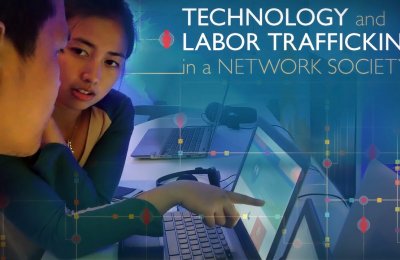By Jeremy Rosenberg
Call it a coming-out party.
A scant four-and-a-half months after its launch, the Annenberg Innovation Lab (AIL) held last Friday what's anticipated to become an annual event, the Annenberg Innovation Lab Conference.
Directed by USC Annenberg professor Jonathan Taplin, the Innovation Lab's high-risk, high-reward purview involves incubating cutting-edge ideas, insights and tools and bridging the gap between that institutional research and the private marketplace.
"If we can all work together – companies, researchers, and academics," Taplin said near the conclusion of the event, "then we can make some big changes."
The Conference was subtitled "See With New Eyes" and attended by ranking representatives of each of the groups Taplin mentioned. Sub-themes that carried throughout the day included consumer and political behavior, pedagogy and the notion of cooperative – or collective – revolution (article by Henry Jenkins, Provost’s Professor of Communication, Journalism and Cinematic Arts here).
The Conference began with welcoming remarks from USC Annenberg Dean Ernest J. Wilson III. The Dean referenced cyberpunk author William Gibson and said the Innovation Lab is an experiment bound to have failures as well as successes.
Wilson noted the rapid pace of the Lab's genesis. "This," Wilson said, "is probably the fastest start-up in the history of the Western world – in a university." The dramatic pause drew laughs from the crowd.
USC Provost Elizabeth Garrett was on hand and spoke later, calling AIL "an enormously exciting possibility."
Garrett also saluted the cross-disciplinary teams of USC students who participated in the Lab's CRUNCH Design Challenge. Winning projects – each awarded $3,000 – were announced Friday in four categories: Future of eBooks, Transmedia Storytelling, Community Platforms and Tools & Applications.
The winning students projects were: New Quill, Interactive GeoSurfaces Map, NimbleTrek and Combiform. The latter, a collaboration between Cinematic Arts students Andy Uehara and Edmond Yee, demonstrated the duo's inventive four-controllers-into-one video game system that is at once social, physical and interactive. Students from each of the winning projects received a strictly enforced three-minute time limit to make a live elevator pitch to the audience.
The CRUNCH awards were sandwiched by the primary purpose of the day – five panel discussions populated by scholars, business executives, a government official, and a famous musician.
T-Bone Burnett is the latter. He's the award winning player, producer and longtime Taplin friend who appeared on the panel, "Speed Bumps on the Digital Highway."
"Speed Bumps'" panelists – like fellow speakers throughout the day – traded anecdotes and analysis about topics such as investments, infrastructure, intellectual property, public policy, engagement and analytics.
Burnett and Taplin were joined on the Davidson Conference Center stage by IBM's Steve Canepa, Levi Strauss & Co.'s Larry Ruff, Verizon's Link Hoewing, Intel Corporation's Sriram Viswanathan, and Qualcomm's Peter Marx.
Levi Strauss, Verizon, and Intel are among the sponsors of the Innovation Lab – Mattel and DirecTV are two others. IBM's Canepa is a member of the Innovation Lab's advisory board.
Some of the Speed Bump seven provided case studies of their various companies' "near death" experiences and elucidated the strategies that revived the firms. The panel opened with an example that symbolizes the sort of work the Innovation Lab intends to take on: Coming up with a new and improved audio standard for streaming music from the cloud.
By way of explaining why doing so is urgent, Burnett slung barbs at the music industry and at the popular compressed file type he considers loathsome. "MP3 at this point is as dead a medium as the 8-track cassette cartridge," Burnett said.
In order to demonstrate the sonic limitations of MP3s, the musician played a track by the late bluesman Jimmy Reed. The track alternated between a higher-quality, less compressed, format and the one Burnett despises.
The difference a technology upgrade can make was also visible during the day's first panel, "The Social Web Meets the Semantic Web." In this session moderated by USC Annenberg professor Sarah Banet-Weiser, AIL Ph.D student Laila Shereen Sakr took the audience through her recent research that includes parsing social media entries from the Middle East – and elsewhere – and turning them into data visualizations.
Thanks to her involvement with AIL, Sakr gained advance access one recent day to an IBM large database software beta called Big Sheets. By the next morning, Sakr had been able to download and do a semantic analysis of 800,000 tweets with the #Jan25 hashtag. Sakr next used the publicly available IBM connective diagramming program, Many Eyes, in order to present the findings on her website, R-SHIEF.
Gregor McElvogue, a fellow "Social Web" panelist and an IBM employee who said he was speaking for himself, said that he and his colleagues were awed by how quickly and effectively Sakr utilized Big Sheets.
"Our jaws literally hit the table," McElvogue said. Panelist Tim Receveur, from the State Department, said he was likewise fascinated by the data analysis.
The Conference's other panels were titled, "The Cloud, Education and Public Policy," "Cultivating the Imagination for a World of Constant Change," and "The Importance of Play."
The latter included Mattel's Stephen Lister launching projectiles towards the audience from a cast on his injured foot, USC Annenberg's Susan Resnick West saying she'd been called "the FAO Schwarz of consultants," and USC's Henry Jenkins noting that he'd included "play" on his list of eleven new skills in his MacArthur Foundation white paper, Confronting the Challenges of Participatory Culture: Media Education for the 21st Century.
In other news from Friday, Taplin announced that the Lab will get its own dedicated space beginning Aug. 15, 2011. The new area, Taplin said, will include USC's first dedicated telepresence system, courtesy of Cisco.









